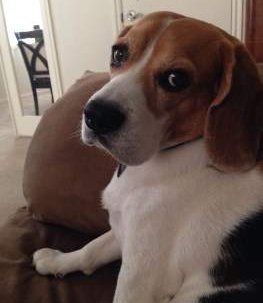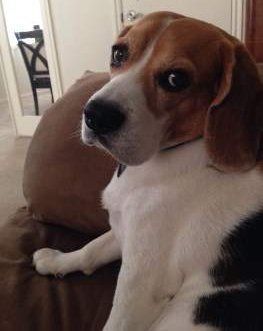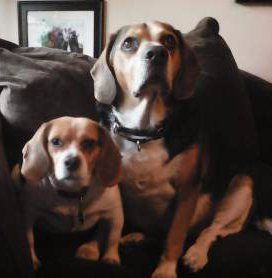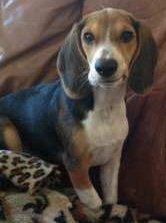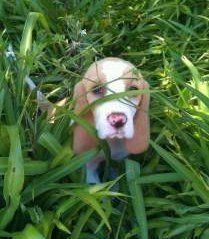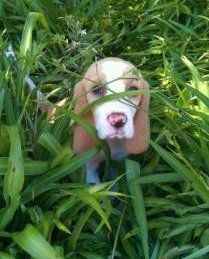Beagle Car Sickness
Overview
It is not uncommon for a Beagle puppy or dog to get car sick, even if only in the car for a short drive. Taking your Beagle with you to run errands or bringing your Beagle to parks and other recreational areas is part of the fun of having a dog, so when motion sickness enters the picture this can become quite a problem.
Your travels with your Beagle shouldn't have to be limited by his/her tolerance to being in the car; so this article will offer some great tips to help a Beagle feel more comfortable and be free of car sickness.
This section will discuss:
- Signs and Symptoms
- Why canines get car sick
- Exact steps you can take to help your Beagle tolerate being driven
- When veterinary intervention is in order
Toby, photo courtesy of Carolyn Bennett
Please note: BeaglePro is reader-supported, and some of the product suggestions on this page are affiliate links. As an Amazon Associate we earn from qualifying purchases. This is at no extra cost to you and helps us keep this site running.
Signs and Symptoms
Vomiting
- This is the #1 symptom that Beagles of all ages will have and this is what most owner are referring to when talking about how their Beagle cannot tolerate being in the car.
If the dog has recently eaten, he may regurgitate partially undigested food and if his stomach is empty, a yellowish liquid possibly with foam (stomach bile) may be thrown up.
Excessive drooling
- This is another common symptom. If a Beagle is really struggling with car sickness, he may have really thick, uncontrollable slobber. Some Beagles will drool
right before throwing up, however this can be a stand-alone symptom.
Heavy panting
- A puppy or dog may breathe very heavy, as if he is very hot even if the temperature is just fine.
Frantic behavior
- Whether or not other symptoms manifest, a Beagle may struggle to get out of his confines, and if he is not strapped in (not recommended) he may actually try to wiggle out of the window which of course can be exceedingly dangerous.
Whining
- This is common with young puppies; although a Beagle of any age may whine due to the distress that they are feeling.
What Causes Car Sickness
Dogs get motion sickness for the same reason that humans do, although there is an additional issue that tends to make it worse for them.
It all starts with the workings of the inner ear which tells the brain what type of motion the body is feeling.
When enclosed in a car, the signal that the inner ear is sending conflicts with what the eyes see…and this can cause car sickness.
With canines, another issue that comes into play is stress.
If a Beagle puppy or dog is feeling anxious about being in the car, this can either appear to be car sickness in regard to acting frantic, panting and drooling or it can exasperate actual motion sickness.
Puppies are more prone to car sickness due to the inner ears not being fully developed; for this reason right about the 18 month mark a Beagle may start to have better tolerance for car rides.
How a Beagle is positioned, the duration of the ride and what the dog did or did not eat will all have an effect on how sick he becomes. The effects of this can begin almost immediately and often subside within 10 to 15 minutes of being freed from the car.
How to Help a Beagle with Car Sickness
There are quite a few things that you can do to help your Beagle feel better when being driven around. Usually just one of these things will have very little effect; however when most or all of them are implemented, it can make a huge difference.
Positioning
- This is one of the most important elements to help a puppy or dog. Since most of the problems occur because a dog is moving (the car is moving forward anywhere from 1 to 65 mph) yet staying still (no one in the vehicle is actually moving in relation to the car itself) at the same time and this is confusing to the brain and makes a dog sick.
So, where a Beagle is and his ability to see out of the window plays a large role.
In general, it is advised to NOT place a dog in the front seat. This is because front passenger air bags can severely injure a pet or even be fatal such an accident occur.
However, if a Beagle gets really sick in the car, many owners find that it helps to A) Disable the air bag (if possible) and B)
Slide the front passenger seat as far back from the dashboard as possible.
Fiona (6 years old) & Ronan (7 years old)
Photo courtesy of owner: Diana Bailey
The next part of positioning to avoid car sickness is to have the Beagle facing forward. You may think that restraining your Beagle would be counterproductive to his panicked feelings; however the correct canine seat restraint will actually help quite a bit.
Once a Beagle is secured, he will remain facing forward, which allows him to view the road and see that he is actually moving which often can cure car sickness for many dogs.
Stability -
Another reason why a car restraint or seat works so well to cut down on motion sickness is that it keeps the dog secure. If a dog is unrestrained, he is moving in a way that that does not match the forward or turning motions of the car, and his body sways with turns and stops; this all leads to more nausea.
Puppies
under the age of one year old do best with bolstered car seats that rise them up high enough to look out. Dogs can be secured to these via either the collar or harness which connects to a safety loop; it is dangerous to use the collar since this can cause strain on the neck, so do be sure to use a harness.
For older Beagles that are large enough to clearly see the road without being in a car seat, a simple canine safety belt strap is best. Do be sure that this is properly secured and sized appropriately so that the Beagle is safe and cannot turn around.
And this isn't even to yet mention the very important fact that buckling up your Beagle is a huge step in prevention injury or even death.
There are 16,000 car accidents per day in the U.S. and a 25 lb. unrestrained dog will be thrown with the force of a 875 lb. object in a crash going 35 MPH.
Partially open a window - While there are some dogs that love sticking their heads out of a window, this does not always help a Beagle that is car sick. This is because 1) it puts him in a side-ward position and 2) the rushing air when driving over 40 mph can feel overwhelming to a dog that is already uncomfortable with car travel.
In any case, this is actually rather dangerous and especially for dog breeds with long dropped ears like the Beagle. Sticking his head out of the window over any speed of 40 mph or greater can:
* Cause damage to the ears
- When the long ears of a Beagle flap in high winds for an extended time (10 minutes or more), this can cause the pinnae to become irritated. Also, blood can pool in the ear flaps, causing them to become swollen. This is a form of trauma and with repeated exposure it can cause chronic ear issues.
* Cause damage to the eyes
- Tiny pebbles, dust and other debris and even bugs can hit the eyes at high rates of speed, causing injury to the corneas.
Since the feeling of fresh air often does help with car sickness (and it helps balance indoor and outdoor air pressure which can help) it is recommended to partially open the window based on regulating the temperature (next tip) as well as controlling how much wind rushes in and how that affects your Beagle's ear.
Buckshot, 2 years old
Photo courtesy of Stacy Dantzler
Keep the temperature cool
-We all have our preferences in regard to how cool or warm we like the car to be when we drive, however if your Beagle gets car sick a lot its best to keep it a cool 65 to 70 degrees Fahrenheit ( 18 to 21 C). When a dog becomes hot, this can exasperate feelings of nausea.
Timing of food / certain snacks
- If possible, you will want to avoid putting your Beagle in the car right after he eats, however a small snack can often help.
There are two methods found to work well for canines. The first is to offer a dry biscuit since this can absorb some stomach acid (similar to how a piece of toast can help you when you have an upset stomach).
The other is to give a dog one small piece of a sugar treat; a small sugar cube or a jelly bean is often used. You must be careful to limit this to one (dogs can get 'sugar highs' which can make them very antsy) and also that any candy does not contain artificial sweeteners and of course, no chocolate.
Stop for breaks -
Owners who have dogs that get sick in the car often have a mindset of 'get there quickly and get it over with'.
But dogs that have a very low tolerance for cars often have a 'breaking point'; there will be that line in the sand that if crossed, the dog will then begin to get sick and things will spiral downward from there. Take note of how long it takes for your Beagle to begin to show signs of sickness. If his limit is 15 minutes and your drive is 25, plan ahead to take a 5 or even 10 minute break before he reaches that mark. Once you pull over to a safe area, allowing your Beagle to stretch his legs and have a drink of water can give him a 'reset' that allows him to be okay for the remainder of the drive.
Offer stress-reducing items
- There are some Beagles that simply dislike being in the car and become super stressed even being put in but will not actually vomit… and there are those that face both issues. For Beagles that are anxious as well as queasy, it can help to have a few distractions to help them relax. A new toy usually works best and if you offer something new for each car ride, you can end up with a nice collection of toys that are kept in the car and only given when driving.
Does desensitization work?
The idea behind this method is to gradually introduce a dog to a certain element or situation that normally causes stress or puts the dog on high alert at slowly increasing intervals to help him build up a tolerance.
This will only work in regard to a Beagle feeling stressed in the car however will not help with the actual issue of motion sickness. If a dog's body responds to motion by getting nauseous, no amount of 'training' is going to change that and exposing him to this over and over will not help at all…it will just give your dog unnecessary stomach problems and needlessly place him under duress.
If a Beagle previously had a lot of car sickness when young and 'learned' to be okay when older, this is often due to the dog's inner ears fully developing and in most cases, an owner making changes to where the dog is placed, the Beagle grew bigger allowing him a better view, etc.
Supplements for Car Sickness
There are a lot of motions sickness supplements on the market, however very few of them have been proven to work and/or are approved by veterinarians. Some of the less reliable ones have some questionable ingredients like Aconitum Nap, a homeopathic ingredient that actually has some poisonous compounds. So, be careful about some that you might see.
However, one of the supplements for motion sickness that is safe and does work for some dogs are calming chews that are formulated with chamomile and ginger, like Vet's Best Comfort Calming Soft Chews

You would give your Beagle a chew about 1 hour before a car trip.
Another option is aromatherapy spray. Lavender really does the trick for some dogs during stressful situations, and Sniff Therapy's Calming Aromatherapy For Dogs
 is a good choice. You can put some onto the fur around your Beagle's neck or spritz a bandanna that you tie around your Beagle; both of these options allow the calming scent to drift up to his super keen nose.
is a good choice. You can put some onto the fur around your Beagle's neck or spritz a bandanna that you tie around your Beagle; both of these options allow the calming scent to drift up to his super keen nose.
What about Medication?
There are some medications that can help and whether or not an owner should give this to a Beagle really depends on how often the dog is driven and the extent of the car sickness.
If a puppy or dog has proven to get sick very easily and an owner knows that a long road trip will be coming up, it can certainly help to have the veterinarian prescribe something to help.
While Dramamine (dimenhydrinate) and Benadryl (diphenhydramine ) can be given to dogs and these are OTC drugs, you should not give either of these to your Beagle for car sickness without vet approval since these can be dangerous if the dosing is incorrect.
Another option is Cerenia which is an FDA-approved medication for safely and effectively preventing nausea due to motion sickness in canines; this is often given for long car rides (over 2 hours) as one single dose lasts for 24 hours.
Rupert, 3 years old
Photo courtesy of Etienne Roux
When to Seek Vet Help for Car Sickness
If the recommendations listed above do not help your Beagle or if you feel that his/her symptoms are severe enough to warrant medication, it will be time to speak to your vet about prescribing something to help your puppy or dog.
Also, some illness may disguise themselves as motion sickness; an upset stomach or other health condition may coincide with a drive in the car. If your Beagle is let out of the car and continues to vomit, drool, pant or show any other signs of illness 30 minutes or longer afterward, this is a reason to call the vet. Most dogs recover from car sickness rather quickly.
You May Also Like:
Care Tips for Beagle Dogs
- A roundup of the most important care elements for Beagles of all ages. Even experienced owners can use these reminders.
How to Help a Beagle with Separation Anxiety
- Leaving your Beagle home alone is never fun for owner or dog; great tips to help.

